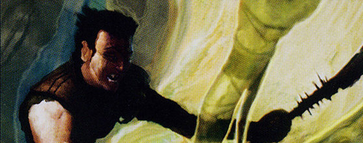We did it! The RAV-TSP Standard Cube has been voted into CubeCon 2025, and now the process of refining it begins in earnest. I’ve been consuming a lot of cube media lately, and one thing that gets consistently emphasized is knowing your audience and your goals. I’ve certainly thought a lot about my goals, but haven’t ever written them down or referred back to them while working. So! To start the revision process, I want to explicitly state my goals and think a little about where I’m at with regards to them.
Goals of the cube (ranked):
- Capture the gameplay feeling of this era (big question: what does this even mean?)
- Healthy balance between accessiblity to players who have never seen the cards and rewarding format knowledge
- Decks line up in a way representing the archetype diversity of the format
Capture the gameplay feeling
My most critical goal being something I can’t readily define is a little concerning, especially given how powerful nostalgia can be. The stuff that quickly comes to mind is like a laundry list of boomer Magic player whining: individual cards are less game deciding, decks run out of resources more easily, upfront or self-protecting value requires a larger investment. But beyond that, there’s an element that I can identify if I can’t yet define, and going forward I’d like to work better to identify where the cube’s succeeding or failing.
Balance rewarding format knowledge with generic evaluation
With this format having a bit of a midrange bent to it, it’s a little easier for people to come in and take “good cards” in an openish color and do well, but I do want 3-0s to more often than not include some iconic interaction - Compulsive Research + Body Double, Goyf + Rack, Gargodon + Mogg War Marshal, etc. That said, I don’t want weird interactions to be the deciding factor. This is part of why I’m using modern rules rather than damage on the stack, and I want to keep my eyes open for weird nonsense that is more of a trivia test than emergent fun.
Archetype diversity within a draft and between winners
This one is a little odd, because it to some extent one could ask: doesn’t everyone want archetype diversity? But to me, a defining quality of the format in my memory was a “wide open” feeling - the powerful cards and interactions tended to be consistent, but a variety of decks could do well both across and within . To some extent, this was due to Magic being very different back in the day, with less data, fewer large events, and more difficult card acquisition. However, even year-to-year in this era, we see a very different picture in 2007.

Draft builds in its own self-balancing as far as specific color combos and tools, but I do want to make sure the meta-archetypes are well balanced against each other. Especially when players aren’t leveraging the synergies in midrange and aggressive decks or assembling combos, there’s a real risk of players with a pile of good fixing and interaction steamrolling the table.
How’s it going?
Capture the gameplay feeling
Other than not being able to define what I’m after, I’m pretty happy with where things have appeared to be. There’s freedom to experiment, but the decks that have done best have created interesting gameplay and back and forth games. Hopefully as I get better at putting my goals to words and watch more games played, I’ll know better how to pursue this goal.
Balance rewarding format knowledge with generic evaluation
This has been a little bit of a struggle so far - generic value (such as it exists here) and hard control with a few splashy wincons have overperformed relative to the synergy decks for the most part. I was very happy to see a GW deck with some aura/hexproof shenanigans go the distance in my first paper playtest, but creature combo and the sacrifice deck haven’t really happened yet. I’ve bumped up some counts for the sac deck, and will see if I can find ways to encourage the creature combo decks without overdiluting the more generic value.
One thing I’m a little worried about at the moment is the presence of “trap” archetypes. Other than the titular card in Dragonstorm, there’s not too much dead weight and people so far have correctly read it as a “live the dream” type deck. In constast, some of the slivers that played an important role in the format were played purely for their built in value at the time, which has lead to some confusion about the existence of slivers as a designed archetype. Other than calling it out in the primer, I’m trying to add a little more support for a small sliver package, but I’m not sure if that’s making the problem better or worse. Sliversmith looks to me like a cute token generator with some incidental reanimation synergies, but it may trick others into trying to hard commit to a sliver deck that isn’t really there.
Archetype diversity within a draft and between winners
This has probably been the largest success so far: finals have involved aggro, midrange, and control. If that can stay relatively stable with more testing across a wider group, I’ll be delighted.
